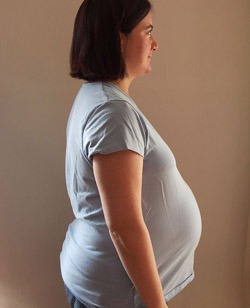35 weeks pregnant, your baby is now ready to breathe. Being born this week probably still means spending some time in the incubator, but most often only for warmth and possibly food.
Mom may be feeling quite heavy and uncomfortable. Wondering where all that weight increase comes from? It is certainly not all from your baby, who is now likely to weigh some 5.5 pounds. Learn about the composition of your weight gain here.
Week 34 | Week 36

What to Expect When 35 Weeks Pregnant?
In this article:
How many months is 35 Weeks Pregnant?
At 35 weeks, you are in month 8 of pregnancy. With only one month left to go, you are close to finishing this final, third trimester.
If you still have trouble understanding how are the pregnancy weeks and months counted, we prepared a post that will make it more understandable. Don’t worry. It is a common source of confusion because it’s said that pregnancy lasts 40 weeks but 9 months, which doesn’t exactly sound correct and logical. But there is an explanation for it, and we will help you understand it here.
Your Baby at 35 Weeks
How Big is my Baby at 35 Weeks?
The fetal age of your baby is now 33 weeks. He or she is now approximately 5.5 pounds (2.5 kg) and over 18 inches in length (46 cm).
At 35 weeks, your baby is the size of a honeydew melon.
What Does my Baby Look Like at 35 Weeks Pregnant?
Fat stores are continually being added to give your baby that cute plumpness that you sometimes see on newborns. Although admittedly, most newborns look quite skinny, at least compared to what they will look like just a few weeks later.
The nails continue to grow on those little fingers and toes and may even be longer than the edge when they are born.
Fetal development
The kidney development is complete, and the liver is beginning to produce waste products where you will begin to see those results come the first few days of your new baby on the outside.
Your baby’s lungs are almost completely developed now.
Although the eyes are most likely blue at this point, they can change color after the baby is born to green or even to brown later.
Your baby’s brain is developing quickly, but the skull remains soft. A soft skull is what makes it possible for the baby to pass through the narrow birth canal.
You may find that your little one is not moving as much as before. Lacking the room for stretching, your baby may be stretching and wiggling less often now but should still stay active inside your womb.
If you notice a dramatic decrease in activity, be sure to contact your doctor or midwife promptly to discuss this. You may be required to count fetal movements as a record of your little one’s activity for reference.
Mom’s Body When 35 Weeks Pregnant
The Belly
 Being 35 weeks pregnant, you may have gained anywhere from 24 – 29 pounds (11-13 kg) in total by now.
Being 35 weeks pregnant, you may have gained anywhere from 24 – 29 pounds (11-13 kg) in total by now.
Do not stress if you have gained more or less than expected. Each woman’s pregnancy is different, and even women who have had multiple pregnancies may notice that one pregnancy weight gain is not identical to another.
If you have any questions or concerns with the amount of weight you or your baby have gained during this time, be sure to discuss those with your health care practitioner.
Pregnancy Symptoms
You may be feeling increased pressure from the baby sitting low, and the increased weight can make you very uncomfortable during these last few weeks.
Many women will seek out methods to help deal with this pain, such as pregnancy massage. Although you may not be able to lie down flat on a table, there are many certified massage therapists that deal specifically with pregnancy massage and can work around your growing abdomen to help you deal with any muscle aches and pains you may be experiencing.
You are probably experiencing fatigue, which is not unusual at this point. One of the reasons for it might also be sleep troubles. It is hard to find a comfortable position with all the aches and pains, the size of your belly, leg cramps, etc. However, try to sleep on your side because that is an optimal sleeping position throughout the whole third trimester. If possible, it would be best to sleep on your left side because this position allows for more nutrients and blood to reach the placenta and the baby. Using pillows for support or a pregnancy pillow might help you to find a more comfortable position.
If the baby dropped into the pelvis, you might feel that some uncomfortable symptoms, such as heartburn or shortness of breath, are relieved or have even disappeared.
Because your baby is pressing on your bladder, you have a frequent need to urinate. It is annoying, especially when you try to go to sleep and have to get up constantly. However, cutting back on fluids to prevent the constant need to pee is not a good idea. You need to be well hydrated and drink plenty of water throughout the pregnancy.
Drinking plenty of water and eating foods rich in fiber can help to prevent constipation and hemorrhoids.
Many women experience swelling in the legs and feet. Some of the reasons for it are hormone changes and the fact that your body retains more fluid during pregnancy. Try to avoid standing for long periods and make sure you rest with your feet in an elevated position multiple times a day.
Your ligaments are loosening in preparation for the delivery, which is often followed by hip and pelvis pain.
Back pain is a common issue at this point. It might also be accompanied by sciatica. Sciatica can be felt as pain that goes from your lower back, through your buttock area, and into your legs. It might also be characterized by numbness or weakness in these areas.
If you notice fluid leaking from your breasts, it is what is called colostrum or pre-milk. This is the first stage of breast milk that will last for a few days after the baby’s birth. Some women don’t leak colostrum during pregnancy, but that is not a reason for worry. No matter if you start leaking colostrum during pregnancy or not, it is considered normal.
As the pregnancy advances, an increase in vaginal discharge might be noticed. However, if you feel a steady trickle or a gush of fluid, it might actually be amniotic fluid. If you think that what you are experiencing is the amniotic fluid leaking or you aren’t sure if it’s amniotic fluid or a discharge, contact your doctor.
A decreased sex drive is one of the many other side effects women experience when coming closer to their expected due date. This can be from a combination of overall discomfort, lack of sleep due to frequent urination, or even constant heartburn or hemorrhoids, which can interfere with the desire to be intimate.
Make sure to keep open communication with your partner during this time. Remember that low libido is common and normal at this stage and will continue to be common and normal long after your baby is born, especially if you breastfeed. That is not to say that no new mom has a desire for sex, but many experience lower drive. To learn more about libido after pregnancy, click here.
You might experience your abdomen tightening as your body is preparing for real contractions. These false, practice uterine contractions are called Braxton Hicks contractions. Unlike true contractions, Braxton Hicks contractions begin and remain irregular. They are usually felt only in the front and are painless. They do not increase in frequency, duration, and interval and usually disappear with rest or when you change the position.
True contractions are regular, painful, and remind of period-like cramping. They begin as irregular contractions and become regular and predictable. They don’t stop when you rest and sleep, and they increase in frequency, duration, and interval.
If you think you are experiencing true contractions or are not sure whether they are real or not, contact your doctor.
As your due date is coming closer, it is advisable to learn about some common labor signs. Some common early labor signs are pelvic pressure, lower back pain, abdominal cramps, period-like pains, and increased vaginal discharge or fluid leaking. If you notice any of these signs, contact your doctor immediately.
Things to do and buy this week
If you haven’t already, you might want to consider writing a birth plan. It is important to listen to the doctors, nurses, and midwives and their recommendations. But you probably have some preferences and know how you would like the whole birth experience to go if everything is okay and there are no issues. Having a birth plan allows you to state your preferences.
If it is something you are considering, think about the different pain relief options, such as an epidural. Talk to your doctor about the different options your hospital might offer.
To start learning about the birth process, visit our section about giving birth here.
Get immediate expert help with your pregnancy questions through JustAnswer Pregnancy:Week 35 Pregnancy Video
Diary of a Daughter
What’s it really like being 35 weeks pregnant…? Here’s a true diary from a mom who should have been 35 weeks pregnant. (Me..!)
This week started with contractions every 4 minutes and I was instructed to go to the hospital. The Dr wanted me to stay there, but the contractions ended at the last minute. I was also back to examine my little girl’s cyst. It was gone! Just like that. Wonderful.
My midwife now estimates the weight of our baby to almost 6 pounds (2.7 kilos). If she does remain inside of me in 40 weeks she will weigh around 8.4 pounds (3.8 kilos) when born. A big girl!
But I doubt that she will stay for forty weeks. I think I lost my mucus plug yesterday.
Are you also 35 weeks pregnant? Please share your experiences and thoughts by leaving a comment below!
Read Next About the Third Trimester
- Why does labor have to hurt
- See what your baby is up to in these fetal development videos
- Childbirth videos that are helpful (even when you’re pregnant)
Week 34 | Week 36
References:
Mayo Clinic, Mayo Clinic Guide to a Healthy Pregnancy
Joanne Stone MD and Keith Eddleman MD, The Pregnancy Bible: Your Complete Guide to Pregnancy and Early Parenthood
Nilsson, L; Hamberger, L. A Child Is Born
Soderberg, L., Mammapraktika. B Wahlstroms.
Mittendorf et al (1990), The Length of Uncomplicated Human Gestation, Obstetrics & Gynecology, V.75, N.6, June 1990

Paula Dennholt founded Easy Baby Life in 2006 and has been a passionate parenting and pregnancy writer since then. Her parenting approach and writing are based on studies in cognitive-behavioral models and therapy for children and her experience as a mother and stepmother. Life as a parent has convinced her of how crucial it is to put relationships before rules. She strongly believes in positive parenting and a science-based approach.
Paula cooperates with a team of pediatricians who assist in reviewing and writing articles.






